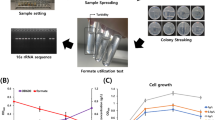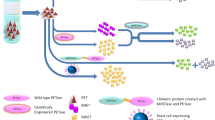Abstract
Polyhydroxyalkanoate (PHA) synthesis genes phaPCJ Ac cloned from Aeromonas caviae were transformed into Pseudomonas putida KTOY06ΔC, a mutant of P. putida KT2442, resulting in the ability of the recombinant P. putida KTOY06ΔC (phaPCJ A.c ) to produce a short-chain-length and medium-chain-length PHA block copolymer consisting of poly-3-hydroxybutyrate (PHB) as one block and random copolymer of 3-hydroxyvalerate (3HV) and 3-hydroxyheptanoate (3HHp) as another block. The novel block polymer was studied by differential scanning calorimetry (DSC), nuclear magnetic resonance, and rheology measurements. DSC studies showed the polymer to possess two glass transition temperatures (T g), one melting temperature (T m) and one cool crystallization temperature (T c). Rheology studies clearly indicated a polymer chain re-arrangement in the copolymer; these studies confirmed the polymer to be a block copolymer, with over 70 mol% homopolymer (PHB) of 3-hydroxybutyrate (3HB) as one block and around 30 mol% random copolymers of 3HV and 3HHp as the second block. The block copolymer was shown to have the highest tensile strength and Young’s modulus compared with a random copolymer with similar ratio and a blend of homopolymers PHB and PHVHHp with similar ratio. Compared with other commercially available PHA including PHB, PHBV, PHBHHx, and P3HB4HB, the short-chain- and medium-chain-length block copolymer PHB-b-PHVHHp showed differences in terms of mechanical properties and should draw more attentions from the PHA research community.




Similar content being viewed by others
References
Abe H, Doi Y, Kumagai Y (1994) Synthesis and characterization of poly((R,S)-3-hydroxybutyrate-β-6-hydroxyhexanoate) as a compatibilizer for a biodegradable blend of poly((R)-3-hydroxybutyrate) and poly(6-hydroxyhexanoate). Macromolecules 27:6012–6017
Andrade AP, Neuenschwander P, Hany R, Egli T, Witholt B, Li Z (2002) Synthesis and characterization of novel copoly(ester-urethane) containing blocks of poly-[(R)-3-hydroxyoctanoate] and poly-[(R)-3-hydroxybutyrate]. Macromolecules 35:4946–4950
Asrar J, Valentin HE, Berger PA, Tran M, Padgette SR, Garbow JR (2002) Biosynthesis and properties of poly(3-hydroxybutyrate-co-3-hydroxyhexanoate) polymers. Biomacromolecules 3:1006–1012
Bates FS (1991) Polymer-polymer phase behavior. Science 251:898–905
Bates FS, Fredrickson GH (1990) Block copolymer thermodynamics: theory and experiment. Annu Rev Phys Chem 41:525–557
Bordes P, Pollet E, Averous L (2009) Nano-biocomposites: biodegradable polyester/nanoclay systems. Prog Polym Sci 34:125–155
Chee JW, Amirul AA, Muhammad TST, Majid MIA, Mansor SM (2008) The influence of copolymer ratio and drug loading level on the biocompatibility of P(3HB-co-4HB) synthesized by Cupriavidus sp. (USMAA2-4). Biochem Eng J 38:314–318
Chen GQ (2009) A microbial polyhydroxyalkanoates (PHA) based bio- and materials industry. Chem Soc Rev 38:2434–2446
Dai SY, Li Z (2008) Enzymatic preparation of novel thermoplastic di-block copolyesters containing poly[(R)-3-hydroxybutyrate] and poly(epsilon-caprolactone) blocks via ring-opening polymerization. Biomacromolecules 9:1883–1893
Dekoning GJM, Lemstra PJ (1993) Crystallization phenomena in bacterial poly[(R)-3-hydroxybutyrate]. 2. Embrittlement and rejuvenation. Polymer 34:4089–4094
Dekoning GJM, Lemstra PJ, Hill DJT, Carswell TG, Odonnell JH (1992) Ageing phenomena in bacterial poly[(R)-3-hydroxybutyrate]. 1. A study on the mobility in poly[(R)-3-hydroxybutyrate] powders by monitoring the radical decay with temperature after gamma-radiolysis at 77 K. Polymer 33:3295–3297
Fiedler S, Steinbüchel A, Rehm BHA (2000) PhaG-mediated synthesis of poly(3-hydroxyalkanoates) consisting of medium-chain-length constituents from nonrelated carbon sources in recombinant Pseudomonas fragi. Appl Environ Microbiol 66:2117–2124
Ha CS, Cho WJ (2002) Miscibility, properties, and biodegradability of microbial polyester containing blends. Prog Polym Sci 27:759–809
Heo KY, Yoon JW, Jin KS, Jin SW, Sato H, Ozaki YH, Satkowski MM, Noda I, Ree M (2008) Structural evolution in microbial polyesters. J Phys Chem B 112:4571–4582
Johnson K, Jiang Y, Kleerebezem R, Muyzer G, van Loosdrecht MCM (2009) Enrichment of a mixed bacterial culture with a high polyhydroxyalkanoate storage capacity. Biomacromolecules 10:670–676
Kamiya N, Inoue Y, Doi Y, Chujo R, Yamamoto Y (1989) The microstructures of commercially available poly(3-hydroxybutyrate-co-3-hydroxyvalerate)s. Macromolecules 22:1676–1682
Kato M, Bao HJ, Kang CK, Fukui T, Doi Y (1996) Production of a novel copolyester of 3-hydroxybutyric acid and medium-chain-length 3-hydroxyalkanoic acids by Pseudomonas sp. 61-3 from sugars. Appl Microbiol Biotechnol 45:363–370
Koller M, Bona R, Chiellini E, Fernandes EG, Horvat P, Kutschera C, Hesse P, Braunegg G (2008) Polyhydroxyalkanoate production from whey by Pseudomonas hydrogenovora. Bioresour Technol 99:4854–4863
Li R, Zhang HX, Qi QS (2007) The production of polyhydroxyalkanoates in recombinant Escherichia coli. Bioresour Technol 98:2313–2320
Lu JN, Tappel RC, Nomura CT (2009) Mini-review: biosynthesis of poly(hydroxyalkanoates). Polym Rev 49:226–248
McChalicher CWJ, Srienc F (2007) Investigating the structure–property relationship of bacterial PHA block copolymers. J Biotechnol 132:296–302
Misra SK, Valappil SP, Roy I, Boccaccini AR (2006) Polyhydroxyalkanoate (PHA)/inorganic phase composites for tissue engineering applications. Biomacromolecules 7:2249–2258
Ouyang SP, Liu Q, Fang L, Chen GQ (2007a) Construction of mpha-operon-defined knockout mutants of Pseudomonas putida KT2442 and their applications in poly(hydroxyalkanoate) production. Macromol Biosci 7:227–233
Ouyang SP, Luo RC, Chen SS, Liu Q, Zheng M, Wu Q, Chen GQ (2007b) Production of polyhydroxyalkanoates containing high 3-hydroxydodecanoate monomer content by fadB and fadA knockout mutant of Pseudomonas putida KT2442. Biomacromolecules 8:2504–2511
Pan P, Inoue Y (2009) Polymorphism and isomorphism in biodegradable polyesters. Prog Polym Sci 34:605–640
Pederson EN, McChalicher CWJ, Srienc F (2006) Bacterial synthesis of PHA block copolymers. Biomacromolecules 7:1904–1911
Qiu YZ, Ouyang SP, Wu Q, Chen GQ (2004) Metabolic engineering for the production of copolyesters consisting of 3-hydroxybutyrate and 3-hydroxyhexanoate by Aeromonas hydrophila. Macromol Biosci 4:255–261
Qu XH, Wu Q, Liang J, Qu X, Wang SG, Chen GQ (2005) Enhanced vascular-related cellular affinity on surface modified copolyesters of 3-hydroxybutyrate and 3-hydroxyhexanoate (PHBHHx). Biomaterials 26:6991–7001
Qu XH, Wu Q, Liang J, Zou B, Chen GQ (2006) Effect of 3-hydroxyhexanoate content in poly(3-hydroxybutyrate-co-3-hydroxyhexanoate) on in vitro growth and differentiation of smooth muscle cells. Biomaterials 27:2944–2950
Ravenelle F, Marchessault RH (2002) One-step synthesis of amphiphilic diblock copolymers from bacterial poly([R]-3-hydroxybutyric acid). Biomacromolecules 3:1057–1064
Romano A, van der Plas LHW, Witholt B, Eggink G, Mooibroek H (2005) Expression of poly-3-(R)-hydroxyalkanoate (PHA) polymerase and acyl-CoA-transacylase in plastids of transgenic potato leads to the synthesis of a hydrophobic polymer, presumably medium-chain-length PHAs. Planta 220:455–464
Saito Y, Nakamura S, Hiramitsu M, Doi Y (1996) Microbial synthesis and properties of poly(3-hydroxybutyrate-co-4-hydroxybutyrate). Polym Int 39:169–174
Schmid M, Ritter A, Grubelnik A, Zinn M (2007) Autoxidation of medium chain length polyhydroxyalkanoate. Biomacromolecules 8:579–584
Shen F, Zhang EL, Wei ZJ (2009a) Surface bio-modification of poly(hydroxybutyrate-co-hydroxyhexanoate) and its aging effect. Colloids Surf B 73:302–307
Shen XW, Yang Y, Jian J, Wu Q, Chen GQ (2009b) Production and characterization of homopolymer poly(3-hydroxyvalerate) (PHV) accumulated by wild type and recombinant Aeromonas hydrophila strain 4AK4. Bioresour Technol 100:4296–4299
Sudesh K, Abe H, Doi Y (2000) Synthesis, structure and properties of polyhydroxyalkanoates: biological polyesters. Prog Polym Sci 25:1503–1555
Tokiwa Y, Calabia BP, Ugwu CU, Aiba S (2009) Biodegradability of plastics. Intl J Mol Sci 10:3722–3742
Tsuge T, Hisano T, Taguchi S, Doi Y (2003) Alteration of chain length substrate specificity of Aeromonas caviae R-enantiomer-specific enoyl-coenzyme A hydratase through site-directed mutagenesis. Appl Environ Microbiol 69:4830–4836
Wang HH, Zhou XR, Liu Q, Wang SY, Li GY, Wang L, Ni H, Chen GQ (2010) Biosynthesis of polyhydroxyalkanoate homopolymers by Pseudomonas putida. Appl Microbiol and Biotechnol. doi:10.1007/s00253-010-2964-x
Acknowledgement
Thanks to Mr. Honghui Wang for kindly making the homopolymers PHV and PHHp for this study. And also thanks to Dr. Shao Ping Ouyang of Tsinghua University for kindly donating P. putida KTOY06ΔC (phaPCJ A.c ). This research was financially supported by the Li Ka Shing Foundation, the National High Tech 863 Grants (project 2010AA101607), and the 973 Basic Research Fund (grant no. 2007CB707804).
Author information
Authors and Affiliations
Corresponding author
Additional information
Shi Yan Li, Cui Ling Dong, and Shen Yu Wang have contributed equally to this paper.
Rights and permissions
About this article
Cite this article
Li, S.Y., Dong, C.L., Wang, S.Y. et al. Microbial production of polyhydroxyalkanoate block copolymer by recombinant Pseudomonas putida . Appl Microbiol Biotechnol 90, 659–669 (2011). https://doi.org/10.1007/s00253-010-3069-2
Received:
Revised:
Accepted:
Published:
Issue Date:
DOI: https://doi.org/10.1007/s00253-010-3069-2




